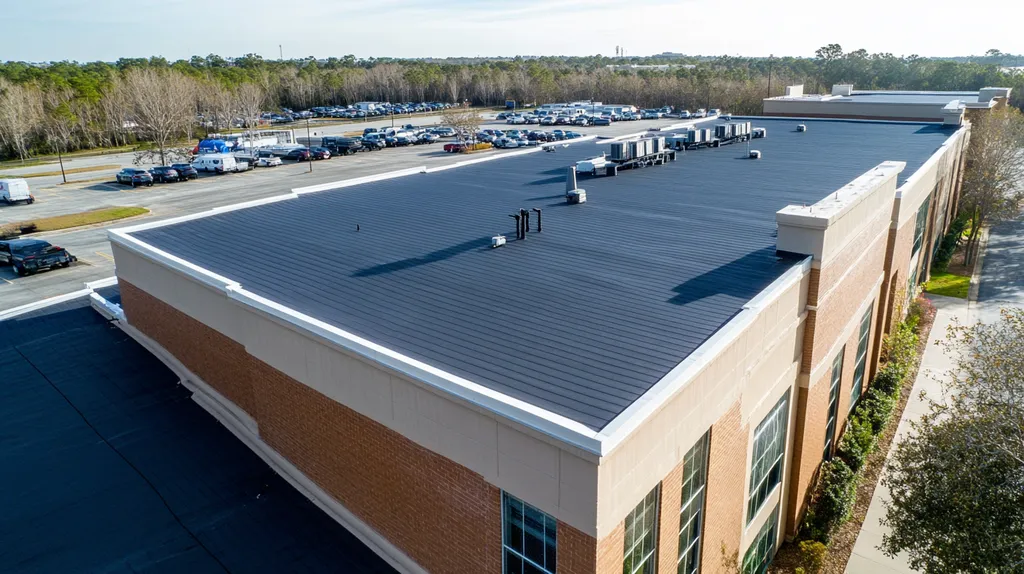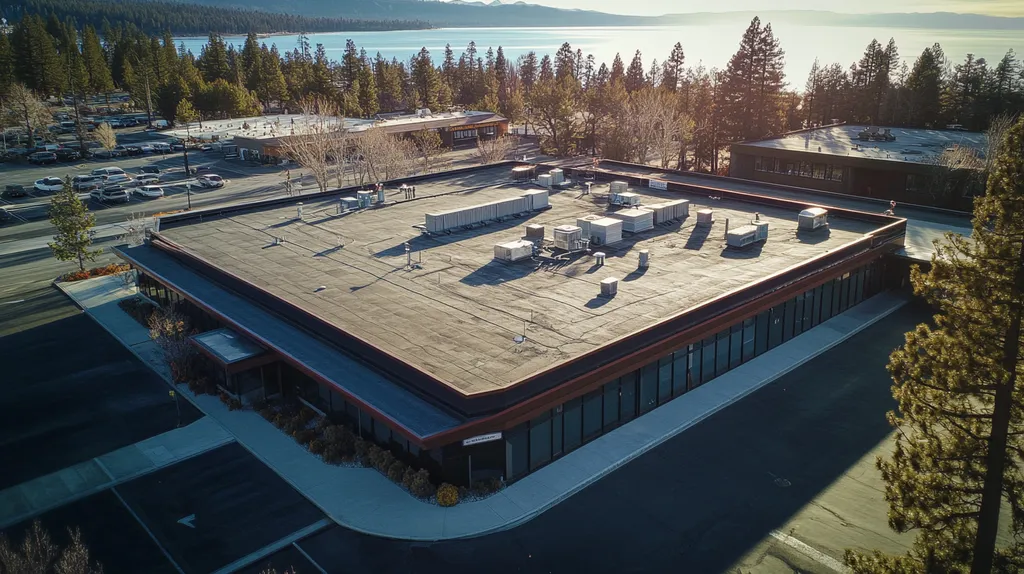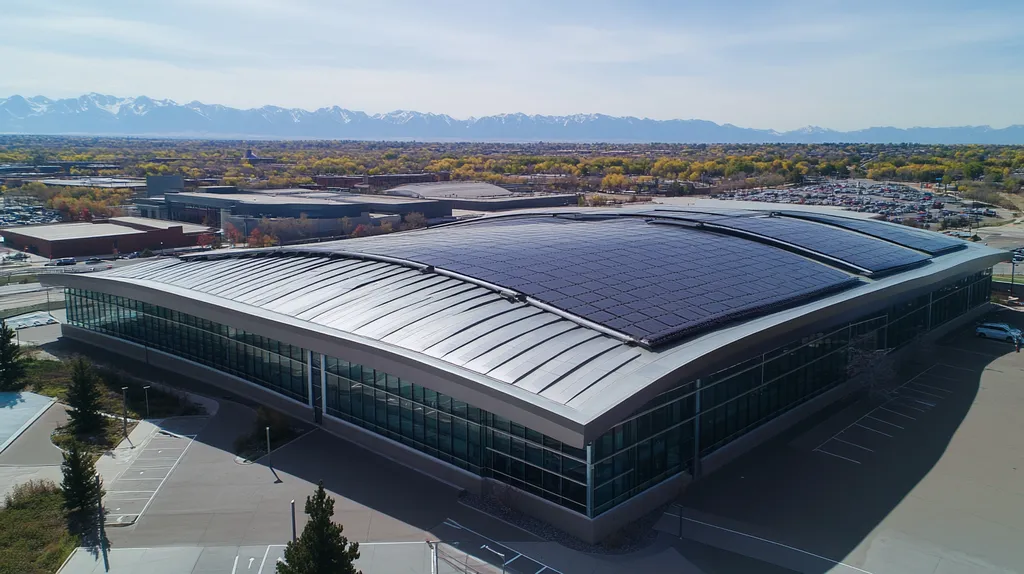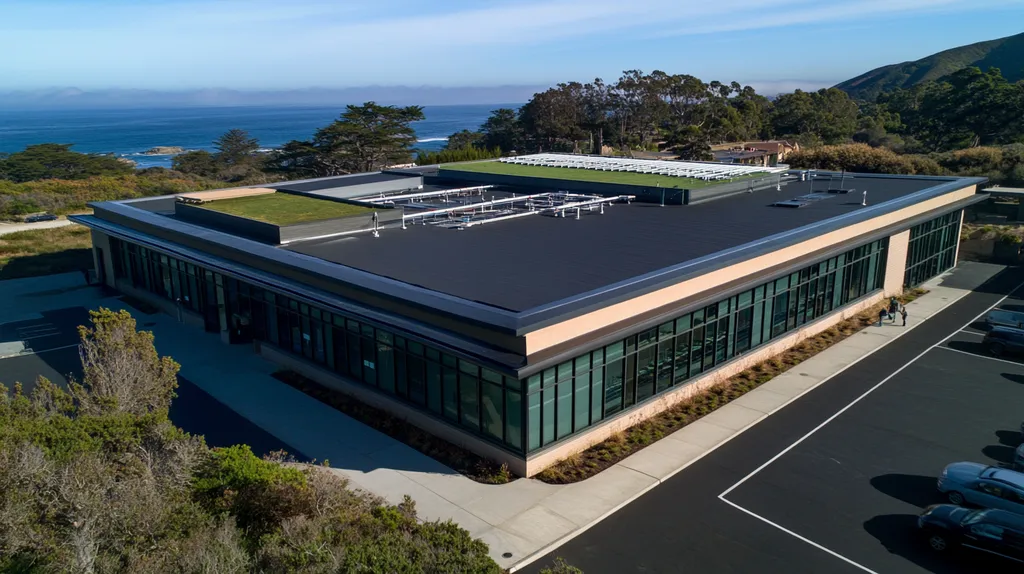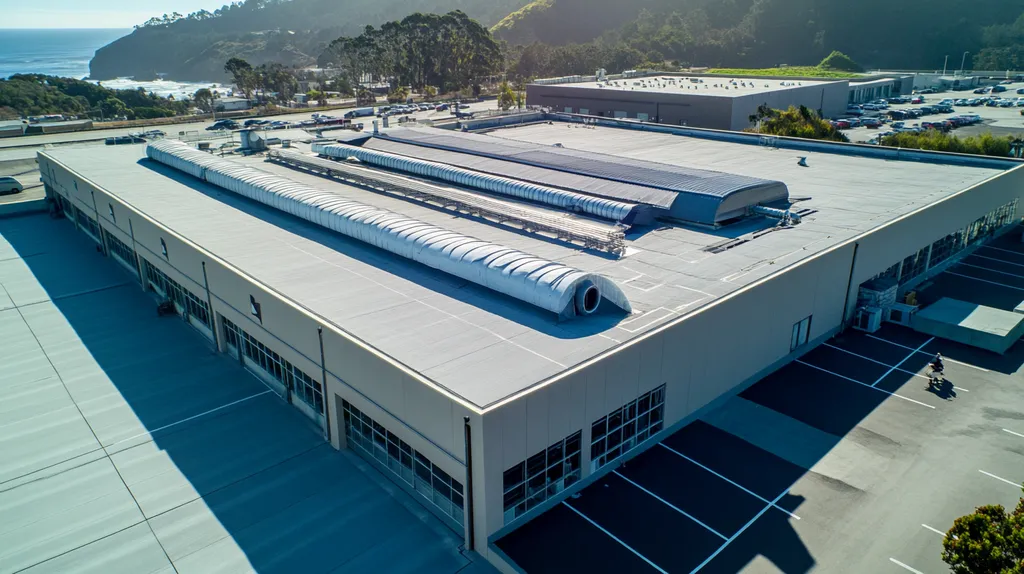Welcome to today’s Battle Royale featuring two roofing heavyweights: “Thermal Imaging” in the east corner versus “Visual Inspection” in the west!
Tonight’s showdown pits these contenders against each other across six punishing rounds designed to test every aspect of their performance for Commercial Roof Maintenance.
At stake? Millions in potential costs, decades of building protection, and the critical performance demands of modern commercial and industrial facilities.
Our professional judging panel will evaluate each round on technical merit, real-world performance, and value delivery. After all six rounds, we’ll declare our ultimate champion.
Ladies and gentlemen, facility managers and building owners… it’s time to rumble!
ROUND 1: INITIAL COSTS & INSTALLATION
Commercial roof maintenance represents a critical investment for property owners, with leak-related damages potentially costing hundreds of thousands in repairs and business disruption. Effective inspection methods can mean the difference between catching issues early and facing catastrophic failures that compromise building operations.
Material Expenses
The initial investment in roof inspection equipment varies significantly between methods. Visual inspections require basic tools like moisture meters, cameras, and safety equipment, typically costing under $1,000 for a complete kit.
Thermal imaging systems represent a more substantial investment, with professional-grade infrared cameras ranging from $6,000 to $15,000. This equipment requires regular calibration and software updates to maintain accuracy.
Despite higher upfront costs, thermal imaging can detect moisture intrusion and insulation failures before they become visible, preventing costly repairs. Many infrared scans can identify issues without disrupting roofing operations. (source: Procore)
Given its superior detection capabilities and potential for preventing major repairs, thermal imaging holds the ADVANTAGE in material expenses.
Installation Complexity
Visual inspections follow straightforward protocols that most roofing professionals can perform with minimal specialized training. These inspections typically involve walking the roof surface and documenting visible defects.
Thermal imaging requires specific environmental conditions and technical expertise to produce accurate results. Inspectors must understand heat transfer principles and how to interpret complex thermal patterns.
While more demanding to execute, thermal imaging provides quantifiable data about roof conditions that visual inspections cannot match. This scientific approach enables more precise maintenance planning.
The comprehensive data provided by thermal imaging gives it the ADVANTAGE, despite requiring more expertise to implement.
Project Timeline
Visual inspections can typically be completed in a single day for most commercial properties. This quick turnaround allows facility managers to address visible issues promptly.
Thermal imaging surveys require specific temperature conditions and often must be conducted during evening hours when heat differences are most apparent. The process includes extensive data analysis and reporting.
While thermal imaging takes longer to execute, both methods can be scheduled to minimize disruption to building operations. Each approach offers distinct timeline advantages depending on specific project needs.
Given the different but complementary benefits of each method’s timeline, this category results in a TIE.
ROUND 1 WINNER: THERMAL IMAGING
ROUND 2: DURABILITY & LIFESPAN
Commercial roof failures can cost businesses millions in repairs, inventory damage, and operational disruptions. The choice between thermal imaging and visual inspections directly impacts how effectively maintenance teams can prevent these catastrophic events. Understanding the durability implications of each inspection method helps facility managers make decisions that protect their roofing investments and extend system longevity.
Impact of Inspections on Roof Lifespan
A commercial roof’s lifespan depends heavily on how accurately and early potential problems are identified. Regular, thorough inspections enable maintenance teams to address issues before they compromise the roofing system’s integrity.
Thermal imaging detects moisture intrusion and insulation failures beneath the surface during temperature changes, providing crucial data about developing problems invisible to the naked eye. This technology enables precise identification of compromised areas before they lead to widespread damage.
Visual inspections can identify surface deterioration but often miss subsurface issues until water infiltration becomes apparent. Many moisture-related problems remain hidden until significant damage has occurred, potentially reducing the roof’s expected lifespan by years.
For maximizing roof longevity through early detection, thermal imaging holds the ADVANTAGE.
Material Degradation Assessment
Different roofing materials degrade at varying rates depending on exposure to environmental stressors. Accurate assessment of material condition determines both maintenance timing and repair strategies.
Thermal imaging provides quantifiable data about material performance and deterioration patterns across the entire roof surface. This comprehensive analysis helps maintenance teams understand how different sections are aging and prioritize interventions accordingly.
Visual inspections rely on observable surface conditions, which may not reflect the true state of materials below. This limitation can result in overlooking areas of compromised material integrity until failure occurs.
Given its ability to detect subtle material changes before visible deterioration, thermal imaging claims the ADVANTAGE.
Long-term Cost Efficiency
Infrared scans can detect moisture that has permeated into underlying roof layers before visible damage appears, enabling targeted repairs that prevent extensive deterioration. These scans are most effective during temperature changes, either during morning warming or evening cooling. (source: Procore)
While visual inspections have lower initial costs, they often lead to more expensive repairs when hidden problems eventually surface. The reactive nature of visual-only maintenance typically results in higher lifetime costs.
By enabling proactive maintenance and preventing major failures, thermal imaging demonstrates superior long-term cost efficiency. This approach helps extend roof life while minimizing emergency repair expenses.
For optimizing maintenance spending over time, thermal imaging shows clear ADVANTAGE.
ROUND 2 WINNER: Thermal Imaging
ROUND 3: PERFORMANCE FACTORS
Commercial roof failures can result in devastating consequences, from inventory losses to business interruptions that cost facility owners millions annually. Understanding how different inspection methods perform in real-world conditions is crucial for protecting these vital assets. The right inspection approach can mean the difference between catching problems early or facing catastrophic system failures.
Effectiveness in Identifying Issues
Visual inspections can identify obvious surface defects like tears, punctures, and visible water pooling. However, this method relies heavily on visible symptoms that often appear only after significant damage has occurred.
Infrared scans detect moisture intrusion and insulation failures beneath the surface during temperature changes, revealing problems before they become visible. These scans can precisely identify compromised areas that would otherwise remain hidden until extensive damage develops. (source: Procore)
Given its ability to detect problems before they manifest visually, thermal imaging claims the ADVANTAGE in effectiveness.
Accuracy and Reliability
Visual inspections depend heavily on the inspector’s experience and judgment, introducing potential variability in results. Environmental conditions like poor lighting or weather can further compromise inspection accuracy.
Thermal imaging provides quantifiable data about roof conditions through temperature differentials, offering consistent results regardless of lighting or surface conditions. This scientific approach enables more reliable problem detection and monitoring over time.
The objective data provided by thermal imaging gives it the clear ADVANTAGE in accuracy and reliability.
Speed and Coverage
Traditional visual inspections require methodical surface examination, making them time-consuming for large commercial roofs. This approach can miss areas that are difficult to access or observe directly.
Thermal imaging allows rapid scanning of large roof areas, providing comprehensive coverage in less time. The technology can quickly identify problem areas for closer investigation, streamlining the inspection process.
With its superior efficiency and complete coverage capabilities, thermal imaging takes the ADVANTAGE.
ROUND 3 WINNER: THERMAL IMAGING
ROUND 4: MAINTENANCE REQUIREMENTS
Commercial roof maintenance represents a critical investment, with inadequate inspections leading to premature failures that cost facility owners millions annually. Studies show that 40% of all commercial roofs require replacement before their intended lifespan due to undetected issues. Understanding the maintenance requirements of different inspection methods helps property managers protect their roofing investments and prevent catastrophic failures.
Equipment Maintenance and Calibration
Thermal imaging systems require regular calibration and software updates to maintain accuracy. Professional infrared cameras need annual recertification and periodic sensor adjustments to ensure reliable readings.
These maintenance requirements represent an ongoing investment beyond the initial equipment purchase. However, properly maintained thermal imaging systems provide consistent, reliable data for years of service.
Visual inspection tools require minimal maintenance beyond basic care and occasional replacement. While this reduces ongoing costs, the simplicity of these tools limits their detection capabilities.
Due to superior detection capabilities despite higher maintenance needs, thermal imaging claims the ADVANTAGE.
Training and Certification Requirements
Thermal imaging demands significant ongoing training to maintain proficiency. Inspectors must regularly update their knowledge of heat transfer principles and pattern interpretation.
Professional certification programs require annual continuing education to maintain thermal imaging credentials. This ensures inspectors stay current with technological advances and best practices.
Visual inspections require basic safety training and general roofing knowledge. While important, these skills are more readily maintained through routine application.
Given its more comprehensive capabilities despite higher training demands, thermal imaging takes the ADVANTAGE.
Inspection Frequency and Scheduling
Infrared scans provide the most accurate results during specific temperature conditions, typically during morning warming or evening cooling periods. These scans can detect moisture intrusion and insulation failures before visible damage appears. (source: Procore)
This timing requirement necessitates careful scheduling but enables thorough subsurface examination. The resulting data helps maintenance teams prevent major failures through early intervention.
Visual inspections can occur during normal business hours without special conditions. However, this convenience comes at the cost of missing developing problems beneath the surface.
For its superior detection capabilities despite scheduling constraints, thermal imaging earns the ADVANTAGE.
ROUND 4 WINNER: Thermal Imaging
ROUND 5: SUSTAINABILITY CREDENTIALS
With commercial buildings accounting for nearly 40% of urban energy consumption, roofing systems play a crucial role in environmental impact and operational sustainability. Recent studies show that ineffective roof maintenance leads to premature replacements of over 2 million tons of roofing materials annually, contributing significantly to landfill waste and unnecessary resource consumption.
Energy Efficiency
Proper roof maintenance directly impacts a building’s energy performance, with compromised systems potentially increasing heating and cooling costs by up to 30%. Identifying and addressing thermal inefficiencies early can dramatically reduce environmental impact and operational expenses.
Thermal imaging provides precise data about heat loss patterns and insulation performance across the entire roof surface. This technology enables facility managers to target specific areas for improvement, optimizing energy efficiency through data-driven interventions.
Visual inspections cannot detect subtle thermal variations or identify areas of energy loss beneath the surface. This limitation often results in overlooked efficiency opportunities and continued energy waste.
For its ability to precisely identify energy efficiency issues, thermal imaging claims the ADVANTAGE.
Material Conservation
Extending roofing material lifespan through effective maintenance reduces waste and preserves resources. Early detection of problems can prevent the need for premature replacement, supporting sustainability goals while reducing operational costs.
Thermal imaging detects moisture intrusion and material degradation before visible damage occurs. This early warning allows targeted repairs that preserve existing materials rather than requiring wholesale replacement.
Visual inspections often miss developing issues until significant damage has occurred. This reactive approach leads to more extensive repairs and premature material disposal.
Given its superior ability to prevent waste through early detection, thermal imaging takes the ADVANTAGE.
Environmental Impact Management
Comprehensive roof management requires understanding both immediate and long-term environmental impacts. Effective inspection methods should support sustainable practices while maintaining building protection.
Infrared scans can detect moisture and insulation issues during temperature changes, enabling precise interventions that minimize material waste and optimize energy performance. This technology supports data-driven decisions that align with environmental stewardship goals.
Traditional visual methods provide limited insight into developing problems, often resulting in larger-scale repairs that increase environmental impact. This approach typically generates more waste and requires more frequent material replacement.
For its ability to support environmentally conscious maintenance strategies, thermal imaging earns the ADVANTAGE.
ROUND 5 WINNER: THERMAL IMAGING
ROUND 6: SPECIALIZED APPLICATIONS
Complex commercial roofing systems protect billions in business assets, with specialized applications demanding precise inspection methods. Studies show that 35% of commercial roof failures occur in areas requiring unique monitoring approaches, from data centers to cold storage facilities. Understanding how different inspection methods perform in these specialized scenarios can prevent catastrophic failures and protect critical operations.
Critical Environment Applications
In sensitive environments like healthcare facilities and data centers, undetected roof issues can have devastating consequences. These facilities require inspection methods that can identify problems before they impact sterile environments or damage expensive equipment.
Thermal imaging excels in these environments by detecting moisture intrusion and thermal anomalies without disrupting operations. The technology can scan large areas quickly while providing detailed data about developing issues beneath the surface.
Visual inspections often prove inadequate for critical environments, as surface-level examinations cannot detect early-stage problems that could compromise sensitive operations. This limitation creates unacceptable risks for facilities where system failure is not an option.
For protecting critical environments, thermal imaging claims the ADVANTAGE.
Cold Storage and Temperature-Controlled Facilities
Temperature-controlled facilities present unique challenges for roof maintenance, where even minor insulation failures can lead to significant energy waste and product loss. These specialized environments require precise monitoring to maintain optimal conditions.
Thermal imaging provides detailed temperature mapping that reveals insulation breakdowns and thermal bridges before they affect interior conditions. This capability enables facility managers to address efficiency issues proactively.
Visual inspections cannot effectively evaluate insulation performance or detect temperature variations that signal developing problems. This limitation leaves temperature-controlled facilities vulnerable to unexpected system failures.
Given its superior capability in monitoring thermal performance, thermal imaging takes the ADVANTAGE.
High-Security Applications
Facilities with elevated security requirements need inspection methods that minimize physical access while maximizing coverage. These applications demand efficient solutions that maintain facility security protocols.
Thermal imaging allows comprehensive roof assessment with minimal physical contact, reducing security concerns while providing detailed condition data. The technology’s ability to scan large areas quickly supports efficient inspection scheduling.
Visual inspections require extensive physical access and prolonged presence on the roof, potentially compromising security protocols. This approach also increases exposure time and security risks.
For maintaining security while ensuring thorough inspection, thermal imaging earns the ADVANTAGE.
ROUND 6 WINNER: THERMAL IMAGING
AND THE WINNER IS…
Ladies and gentlemen, after six brutal rounds of technical evaluation, we have our undisputed champion! In a stunning clean sweep, THERMAL IMAGING has dominated every round of this industry showdown!
This heavyweight contender demonstrated knockout performance in critical categories including early problem detection, comprehensive coverage, and specialized applications. Its ability to identify subsurface issues before they become catastrophic failures proved decisive in securing victory.
Visual inspection, while defeated, remains a valuable complementary tool for routine maintenance checks and situations requiring quick, basic assessment. Its lower cost and simpler implementation make it a practical choice for smaller facilities with limited maintenance budgets.
However, we must emphasize that every commercial property presents unique challenges. Local climate conditions, building design specifications, and operational requirements can significantly impact inspection effectiveness. This analysis provides general guidance but cannot account for all variables. Property owners should consult qualified roofing professionals who can evaluate their specific situation.
And there you have it, folks! In the high-stakes arena of commercial roof maintenance, thermal imaging stands tall as our technical champion. But remember – the true victory comes from selecting the right inspection strategy for YOUR facility’s unique requirements. Now, let’s get ready for the next round of protecting your roofing investments!
FREQUENTLY ASKED QUESTIONS
Q. What are the costs associated with commercial roof inspections?
A. Visual inspections typically cost under $1,000, while thermal imaging systems range from $6,000 to $15,000. While thermal imaging has higher upfront costs, it can catch hidden issues early, possibly saving more on repairs later.
Q. How do thermal imaging and visual inspection impact commercial roof durability?
A. Thermal imaging can identify subsurface moisture and insulation failures early, protecting roof integrity. Visual inspections often miss these hidden issues, leading to premature roof failure and potentially shortening the roof’s lifespan.
Q. Which inspection method is better for identifying commercial roof issues?
A. Thermal imaging excels in detecting problems beneath the surface that visual inspections often miss. This method identifies hidden moisture intrusion and thermal inefficiencies before they manifest as visible damage.
Q. What are the ongoing maintenance requirements for thermal imaging?
A. Thermal imaging systems require regular calibration and annual recertification to maintain accuracy. While ongoing maintenance costs more, the detailed data they provide can significantly improve long-term roof management and minimize failures.
Q. How does roof inspection relate to sustainability in commercial properties?
A. Effective roof inspections can prevent premature replacements, thus reducing landfill waste and conserving materials. Thermal imaging helps identify energy inefficiencies early, aligning maintenance practices with sustainability goals and reducing overall energy consumption.
Q. Can either inspection method be used for specialized applications?
A. Thermal imaging is particularly effective in specialized applications such as healthcare and data centers, where identifying hidden issues is crucial. Visual inspections may not provide sufficient data for these critical environments, leading to potential risks.
Q. When should I schedule roof inspections for commercial buildings?
A. Regular inspections should be scheduled based on weather conditions and roofing material types. For thermal imaging, specific temperature conditions enhance accuracy, while visual inspections can occur during routine hours, making scheduling flexible.

